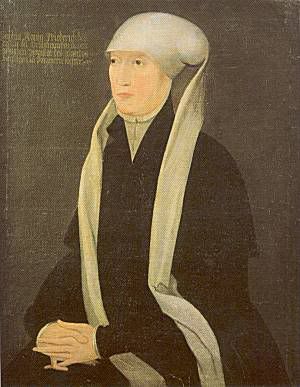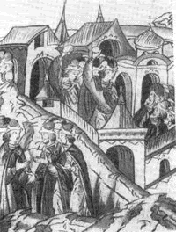Marian I
Part Five, 1479-1486
Part Five, 1479-1486
~In which things fall~
The final straw that pushed Slovakia and Poland into an all-out war was, to borrow a title from a previous chapter, when "violence came to a head." This time as well, it was quite literally. A Polish captain stationed in one of the many border castles was killed during a routine patrol by a group of Bohemian archers. Those are the facts that are known, though intense debate has followed through the centuries over what else is true. Were they in Poland or Slovakia? Did the archers act at the behest of the government or were they one of the dozens of roving mercenary bands that lived in the forest during that time? The identity of the Polish captain has also been called into question, as in was he really a captain or was he just one of the hundred Bohemians press-ganged into the Polish border patrol?
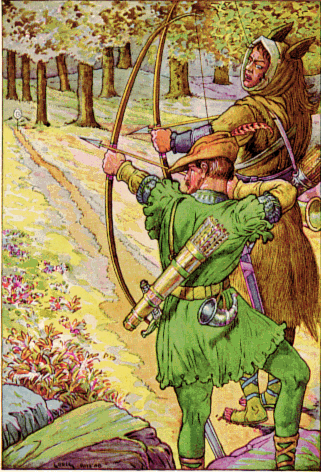
Depiction of the shooter of the Polish Captain. The Bohemain mercenaries often wore green and were more than often Hussites, and were thusly known as the Green Hussites or Forest Hussites.
Whether or not the facts are true one way or the other, on August 30, 1479, Poland declared war on Slovakia. Both sides, as mobilized as possible for this moment, quickly met in dozens of border skirmishes as the larger armies marched on past them. The main part of Slovakia, protected by the spine of mountains that separated the two nations, was relatively safe and most early Polish attempts were easily beaten back down the mountains. However, in the relatively flat Slovak-owned Silesia, major fighting would occur. In the last half of 1479 alone, over six major battles occurred between Wroclaw and Lodz. Despite superior Polish numbers, the Slovaks fought each battle to a strategic draw. Casualties were heavy, and new troops were found in German mercenaries and incoming Bavarians. When winter of 1479 stopped the major fighting, both sides lay in desperate straights already. The Slovaks were down well over 20,000 men and the Poles over 25,000. Most devastatingly, the culverins which had served Slovakia for so long had been destroyed at a battle in Silesia. That, not to mention the state of Silesia itself. The countryside had been essentially destroyed by the opposing armies. The population of Silesia essentially evaporated that winter, with all food being either consumed by or destroyed by the armies.
When spring broke in 1480, the first decisive battle in Silesia arose to much Slovak consternation. The battle forever known in Slovakia as 'The Evil Battle' occurred on April 6, 1480. Over 7,700 Slovaks lost their lives to the Polish onslaught. It turned out that Poland managed to save one of the culverins and turned it against the Slovaks in one of the most, as I must abandon the mask of impartial historian, devious plots in the whole of military warfare. The Poles rolled the culverin from the side of the battle field on the Slovak left-flank. The Slovaks cheered, thinking they had salvaged one as NO Polish army had ever had one. It even flew the Slovak Flag! And, no one seemed to notice that as it was being aimed it was turning ever so slowly towards them. Suddenly, a shot rang out and wiped over 500 Slovak lives from the face of the earth... The culverin managed to get off three more shots before the Slovaks fully retaliated, but by then it was too late. The Poles had won and the retreat was on.
And, retreat they did. The Slovaks retreated all the way back to Prague to wait out the Polish incursion. Meanwhile in the south, the Moldavian front had totally collapsed and the Poles were on the verge of either vassalizing or annexing the country. The Poles besieged city after city, and the Slovaks managed to throw them off. The Slovaks had enough to stop any siege but not even close to enough troops to amount a full-scale invasion. Likewise, the Poles had enough troops to invade but not enough to keep any cities they conquered as the Bavarians proved their worth as allies once again. A stalemate ensued for over two years, with devastation and death reigning down on Silesia and Bohemia. Crops, villages, even the city of Olomouc were put to the torch. The people of Bohemia started to riot and revolt festered to end the horrendous war. Despite this, Marian remained steadfastly against this and was determined to win. However, in 1483, two major events occurred which hastened the closing of this war. First, the major city of Brno fell to Polish troops and no amount of Slovak fighting could get rid of them. Second, the first multi-front attack into Slovakia proper succeeded in spectacular fashion. Polish troops managed to push through the mountains for the first time and take the vital city of Presov, where the Royal Family was from. This blow to the honor and pride of Slovakia would've been enough, but there was another strike to come.

The siege of PResov was conducted with the culverin captured by the Poles. The second smaller one worried Slovaks more as it displayed the leaps in technology Poland had made in the last decade.
The second Polish offensive into Slovakia brought the Polish army to the gates of Bratislava. A siege like no other the city had experienced ensued, with over six months of grueling starvation and death. Finally, when the news of Kosice's fall, the Slovaks had to give in. On October 15, a peace was signed ending one of the comparatively bloodiest and most devastating wars in Slovak victory, not to mention a humiliating loss. The Treaty of St. Steffan saw the annexing of most of Silesia to Poland and a compensation of over 100,000 ducats. The Bavarians had the relatively light punishment of 50,000 ducats thrust upon them. However, the most devastating punishment fell to the Moldavians, who were in essence cleaved and vassalized by Poland.

Treaty of St. Steffan
King Marian could not sit easily on the throne with the specter of a devastating war looming over him. His brother, who had long kept his silence in exile, now returned to Bratislava and spoke openly about removing the King from power. His brother demanded that Marian's eldest son be given the title of King and Marian sent off to retirement in the very lands that lay scorched with the heat of war. Marian flat out refused, and the army kept the peace for the next two years. However, in 1485, Marian had a massive stroke at the age of 59 and was left unable to speak. His brother once more began demanding his abdication, though Marian steadfastly refused.
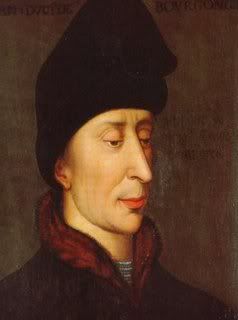
Marian I.
The army, which had long been loyal to Marian, finally started to waver and the soldiers started to join the protestors outside the palace. Not only was there the looming defeat of war, the economic and literal famine wracked the country. All the artists dried up and left, including Vladjo Archestsky. Archestsky left Bratislava in early 1486 for the west, where he lived and worked in Amsterdam fron 1486 until his death in 1499 from diphtheria. After learning of Vladjo Archestsky's absence, King Marian is thought to have finally broken his stubborn hold on power. A month later, on July 17, 1486, Marian I abdicated the Slovak throne in favor of his son Methodius. Marian retired to his manor in Presov where he died later in 1486 of a massive stroke. He was 60 years old. His new son, an able diplomat though no talent at administration or war, was still smart enough to realize that no good King would be complete without one simple name. Instead of ruling as Methodius I, he choose to rule as Vladjo IV.
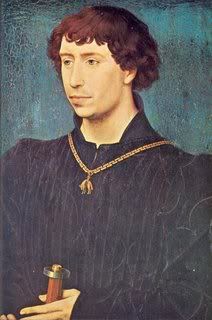
Vladjo IV, King of all the Slovaks



